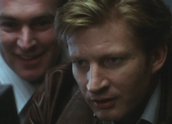


The Bank (2001)
Synopsis
Jim Doyle (David Wenham) is hired by a major bank to perfect his mathematical discovery. He believes he can predict the stock market using chaos theory. His new boss, Simon O’Reilly (Anthony LaPaglia), gives him the biggest computer in the southern hemisphere, and then applies constant pressure. Meanwhile, a nine-year-old boy drowns himself when the bank forecloses on his family’s mortgage. Grief-stricken parents Wayne (Steve Rodgers) and Diane Davis (Mandy McElhinney) bring a court action, alleging the bank failed to disclose the risks of their loan. O’Reilly tells his fixers to make the legal problem go away. Doyle’s new girlfriend Michelle (Sibylla Budd) wonders if Jim has sold his soul to the devil. He wonders if she is a spy for his boss.
As Doyle perfects his computer model, he warns O’Reilly about the implications: if they can foresee a market crash, they could also act to stop it, benefiting millions. O’Reilly sees only a huge profit potential, a score to make his name. To cement Doyle’s loyalty, he asks him to lie before the court, in the Davis case. The bank wins, but Doyle loses Michelle and the respect of his close colleague, Vincent (Greg Stone). Wayne Davis decides to kill the banker who killed his son, just as Doyle unleashes his computer program on the financial markets. O’Reilly discovers too late that Doyle has his own plans for the bank.
Curator’s notes
Robert Connolly’s first film is an indictment of much more than the greed and corruption of one banker, who’s memorably played by Anthony LaPaglia. It’s about the collapse of a sense of compassion in contemporary Australia. The film begins in a classroom in Victoria in the 1970s, when Australian schoolchildren were still given moneyboxes and money to put in them, in order to foster a sense of a relationship between a bank and its customers. Twenty years later, the board members of the fictional Centabank, one of the largest in Australia, are not satisfied with O’Reilly’s results as managing director. In the last year he has closed 1,100 bank branches and sacked one third of the bank’s employees but the board still wants more growth in profit.
Connolly constructs a story in two parts – with the Davis family at the bottom of the social heap, bankrupted and misled by tricky bank policies – and David Wenham’s character Jim at the top end, plotting some kind of financial coup. Between the two, he gives us Simon O’Reilly, an American banker who’s almost a devil figure, although he thinks of himself as the opposite. ‘I’m like God with a better suit’, he says at one point. Given that Anthony LaPaglia could have played the role with his own (original) Australian accent, the fact that O’Reilly sounds American is a deliberate choice by Connolly. The reason is probably to do with his sense of where the changes in Australian corporate culture were coming from in the 1980s and 1990s. At the same time, the film makes clear that the bank’s policies are propelled by a board made up of Australian businessmen. Their ruthlessness is home-grown, and surprises even Simon O’Reilly.
There are few movies about business in the history of Australian film, although there are recent signs that this might be changing, with films such as The Bet (2006) and Risk (2000). The Bank was the first of two films in which Robert Connolly attempted to analyse the changing mores of contemporary Australia. The other film was Three Dollars (2005), also featuring David Wenham. Both films suggested that there was a general hardening of the culture, towards greed and away from compassion. Both films struck a solid chord with Australian audiences.
The Bank was nominated for nine AFI Awards, including Best Film, and won Best Original Screenplay for Robert Connolly’s script.
- Overview
- Curator’s notes
- Video 3 clips
- Principal credits
- Find a copy
- Make a comment
- Map
- Add your review



